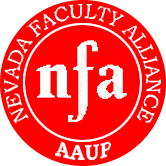For Nevada, the report includes data for UNLV, UNR and CSN only, and it shows -- as have each of the past few annual reports -- that while average pay for Nevada faculty might remain competitive (falling just at or above national averages for comparable institutions, based on 2009 data, before the coming round of pay cuts) but that our total compensation, when benefits are included, falls well below the national average and will doubtlessly fall further behind if the proposed cuts to health benefits are enacted.
While the Great Recession may be technically over in the broader US economy, the same cannot be said in the higher education sector. The results of the American Association of University Professors’ annual survey of full-time faculty compensation are only marginally better than last year’s and represent the continuation of a historic low period for faculty salaries. For the second consecutive year, the overall average salary level increased at a rate less than inflation. And this is the fifth of the last seven years in which overall faculty salaries declined in purchasing power.
With three full years of data now available, we can begin to assess the direct impact of the recession on faculty compensation. This year's report examines two major aspects of the recession's impact: the ongoing expansion of contingent academic employment and growing salary inequality, both within the faculty and between faculty members and college and university presidents.
We released It’s Not Over Yet: The Annual Report on the Economic Status of the Profession, 2010–11 today. The complete report (including the institutional listings of average salary by rank and gender and aggregate tables for comparison) is available on our website. AAUP members will also receive a hard copy of this year’s report in the mail as part of their member subscription to Academe.
In addition to listing average salary by faculty rank and gender at more than 1,300 colleges and universities, the report provides an important perspective on the economic challenges facing higher education.
Here are some highlights:
- The long-term trend toward contingent faculty appointments has continued: federal data from 2009 confirm that graduate student employees and faculty members serving in contingent appointments now make up more than 75 percent of the total instructional staff. Even just between 2007 and 2009, the growth in full-time non-tenure-track and part-time faculty positions outstripped the increase in tenure-line positions.
- Detailed analysis of AAUP data for the recessionary period, from 2007–08 to 2010–11, shows a particular pattern in full-time appointments: the total number of faculty members grew, but most of the new appointments were in non-tenure-track positions. There was also a net increase in tenured faculty appointments, but the number of tenure-track faculty members actually decreased by more than 3 percent.
- The recession's impact on full-time faculty salaries has exacerbated long-term trends in the salary disadvantage for faculty members in public institutions. Disciplinary differences in full-time faculty salaries, including instances of salary inversion and compression, have also grown.
- During this recessionary period, the average salary increase for presidents was twice the average faculty salary increase at public institutions and nearly three times the faculty salary increase at private institutions. Such a disproportionate increase in compensation for a single individual is an indication of misplaced institutional priorities—especially when faculty members and other higher education employees have been faced with involuntary unpaid furloughs, hiring and salary freezes, and cuts to benefits.
Even with the substantial impact of the recession already documented in this analysis, our forecast for the near future is not encouraging. States will continue to have reduced revenue, and that means decreased state funding for the majority of public-sector institutions. At the same time, governors in a number of states have been using the fiscal crisis as a pretext for a broad attack on public-employee compensation.






No comments:
Post a Comment